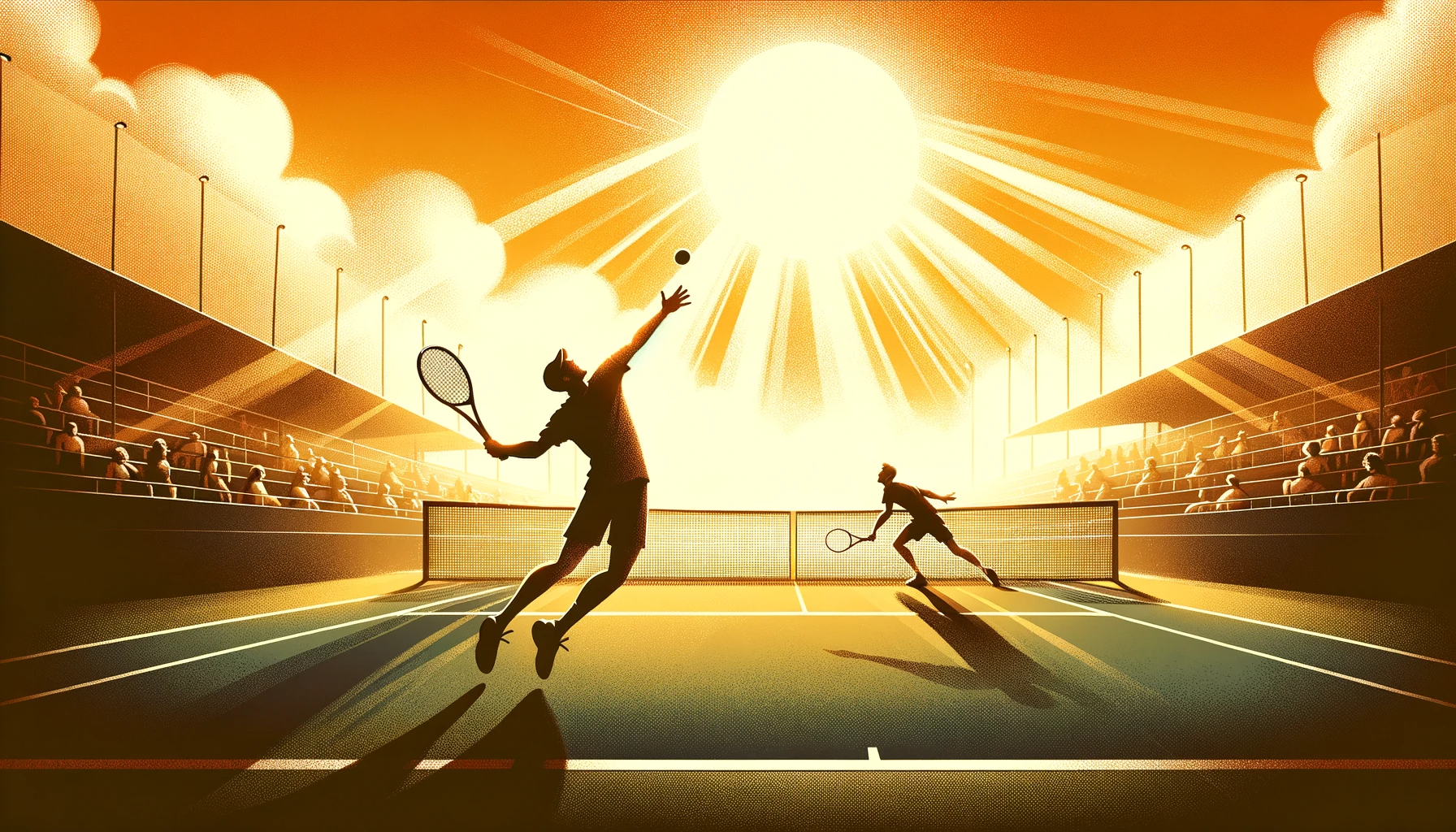While learning a new sport can be intimidating, tennis is a game that is worth diving into headfirst.
In this article, we will address the anticipated objection that tennis is a complex sport and provide a quick start guide to help you jump right in.
From understanding the equipment needed and basic rules to mastering essential strokes and techniques, this informative and concise article will equip you with the knowledge you need to improve your tennis game.
Key Takeaways
- The equipment needed for tennis includes a tennis racket and proper tennis shoes.
- When selecting a tennis racket, important factors to consider are its weight, head size, grip size, and string tension.
- Consulting with a tennis professional or trying out different rackets can help in choosing the right one.
- Proper tennis shoes are important for performance and injury prevention, and characteristics such as durable outsoles and supportive midsoles should be considered.
Equipment Needed for Tennis
To play tennis, you will need specific equipment. Two essential pieces of equipment are a tennis racket and proper tennis shoes.
When it comes to tennis racket selection, there are various factors to consider. The weight, head size, grip size, and string tension are all important aspects to think about. A lighter racket is generally easier to maneuver, while a heavier one can provide more power. The head size affects the racket’s sweet spot and forgiveness, with a larger head providing a larger sweet spot and more forgiveness on off-center hits. The grip size should be comfortable and allow for a secure hold on the racket. Finally, the string tension can impact the control and power of your shots. It is recommended to consult with a knowledgeable tennis professional or try out different rackets to find the one that suits your playing style and preferences best.
In addition to the racket, proper tennis shoes are crucial for optimal performance and injury prevention. Tennis involves a lot of quick movements, so having shoes specifically designed for tennis can provide the necessary stability and support. Tennis shoes typically have durable outsoles, supportive midsoles, and reinforced toe caps to handle the demands of the sport. They should fit securely and provide ample cushioning for comfort. It is essential to choose tennis shoes that are appropriate for your playing surface, as there are specific options for clay, grass, and hard courts. Consulting with a tennis professional or visiting a specialty sports store can help you find the right tennis shoes for your needs.
Basic Rules and Scoring in Tennis
As we delve into the realm of basic rules and scoring in tennis, it is important to build upon our understanding of the equipment needed for the game. Now that we have our rackets and tennis balls ready, let’s explore the different types of tennis courts and the importance of footwork in tennis.
Tennis can be played on various types of courts, each with its own characteristics. The most common types of tennis courts include:
| Type of Court | Surface |
|---|---|
| Grass | Fast-paced with low bounce |
| Clay | Slower surface, high bounce |
| Hard | Medium pace, consistent bounce |
| Carpet | Fast surface, low bounce |
| Synthetic | Variable speed and bounce |
Understanding the type of court you are playing on is crucial, as it can affect your strategy and gameplay.
In addition to court types, footwork plays a vital role in tennis. Good footwork allows players to move quickly and efficiently around the court, enabling them to reach shots and maintain balance. It is essential for players to constantly adjust their footwork based on the position of the ball and the type of shot they are executing.
Proper Grip and Stance for Tennis
Continuing our exploration of tennis basics, let’s now focus on the essential aspect of proper grip and stance for optimal performance on the court.
Mastering the correct grip and stance is crucial to ensure control, power, and accuracy in your shots. Here are three key points to consider:
- Grip: The grip is the foundation of your shot. There are different types of grips, but the most common ones are the Eastern grip for forehand shots and the Continental grip for backhand shots. Experiment with different grips to find the one that feels most comfortable and allows you to generate the most power and control.
- Stance: Your stance sets the stage for your shot execution. The two main stances in tennis are the open stance and the closed stance. The open stance is commonly used for shots that require quick reactions and lateral movement, while the closed stance provides a more stable base for shots that require greater control and power.
- Footwork techniques: Footwork is the foundation of good tennis. Developing proper footwork techniques, such as split steps, shuffle steps, and cross-over steps, will enable you to move efficiently around the court, get into position quickly, and execute your shots with precision.
By mastering the proper grip, stance, and footwork techniques, you’ll be well on your way to improving your performance on the tennis court.
Now, let’s move on to the next section, where we will explore the essential tennis strokes and techniques.
Essential Tennis Strokes and Techniques
In the realm of tennis, mastering essential strokes and techniques is paramount for success on the court. These fundamental skills form the foundation of a player’s game and allow them to compete at a high level.
One crucial aspect of tennis is footwork, which involves the ability to move quickly and efficiently around the court. To improve footwork, players can engage in various tennis footwork drills that focus on agility, speed, and balance.
In addition to footwork, it is essential to understand and correct common mistakes in tennis strokes. One common error is improper grip, which can negatively impact shot accuracy and power. Another mistake is failing to maintain proper technique throughout the stroke, resulting in inconsistent shots. By identifying and addressing these errors, players can improve their strokes and increase their chances of winning matches.
In the following section, we will explore tips for improving your tennis game, including strategies for enhancing stroke technique, increasing shot power, and developing a winning mindset. By implementing these suggestions, players can take their skills to the next level and achieve greater success on the tennis court.
Tips for Improving Your Tennis Game
To improve your tennis game, it is important to focus on specific strategies and techniques. Here are some tips for building stamina and implementing mental strategies for tennis success:
- Building Stamina:
- Engage in cardiovascular exercises such as running, cycling, or swimming to improve your overall endurance.
- Incorporate interval training to simulate the intensity of tennis matches and improve your ability to sustain high energy levels.
- Practice on-court drills that involve constant movement and footwork, such as agility ladder exercises or shuttle runs.
- Mental Strategies for Tennis Success:
- Develop a pre-match routine to help you focus and mentally prepare before each game.
- Visualize successful shots and strategies during practice sessions to build confidence and mental clarity.
- Stay present and avoid dwelling on past mistakes or missed opportunities. Focus on the current point and keep your mind in the game.
Frequently Asked Questions
How Can I Prevent Injuries While Playing Tennis?
To prevent injuries while playing tennis, it is important to follow proper warm-up and stretching routines, use correct technique and form, wear appropriate footwear and protective gear, and listen to your body for signs of fatigue or pain. Common tennis injuries include sprains, strains, and tennis elbow.
What Are the Different Types of Tennis Court Surfaces?
Grass courts and clay courts are two of the different types of tennis court surfaces. Grass courts offer fast-paced play with low bounce, while clay courts provide slower play with higher bounce, allowing for more strategic gameplay.
Are There Any Specific Warm-Up Exercises I Should Do Before Playing Tennis?
Before playing tennis, it is important to engage in dynamic stretching exercises to warm up the muscles and increase flexibility. Additionally, staying hydrated throughout the activity is crucial to maintain optimal performance and prevent injuries.
How Often Should I Restring My Tennis Racket?
The frequency of restringing a tennis racket depends on factors such as playing frequency, playing style, and string quality. As a general rule, restringing every 30-40 hours of play or when signs of tension loss or fraying are evident is recommended.
What Is the Best Way to Choose the Right Tennis Shoes for My Game?
Choosing tennis shoes that are the right fit for your game is crucial. Consider factors such as court surface, foot type, and specific game style to ensure optimal performance and prevent injuries.
Conclusion
In conclusion, tennis is a dynamic sport that requires proper equipment, knowledge of the basic rules and scoring system, and mastering the essential strokes and techniques.
By improving your grip and stance, you can enhance your performance on the court. Remember to practice regularly and seek professional guidance to refine your skills.
With dedication and perseverance, you can excel in the game of tennis and enjoy the thrill of competition. So, grab your racket and start swinging for success!








No Comment! Be the first one.